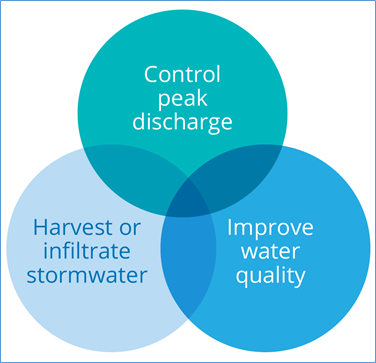The traditional approach to minor system flood mitigation has been the inclusion of stormwater detention requirements for new developments to manage peak flows. In some Council areas, catchment conditions dictate that the overall volume discharged is also a critical design factor and therefore retention is being sought in lieu of detention requirements.
The 2019 Australian Rainfall and Runoff (AR&R) standard

Potential overlapping volume management design objectives (ARR 2019 figure 9.4.1.) |
In 2019, Engineers Australia released the new ARR 2019 guide – a guide to flood estimation. ARR is the main standard used by civil engineers and hydrologists in Australia for design of stormwater infrastructure. This is the first major update of this standard since 1987, and it is a step change in how stormwater infrastructure is designed.
In the last 30 years, stormwater approaches have evolved significantly, and the 2019 ARR guide introduces multiple objectives as well as flood mitigation (e.g. resilience, WSUD, liveability, sustainability and affordability) and the perspective of other disciplines such as aquatic ecology and landscape design[1].
Strategic use of water efficiency, rainwater, stormwater infiltration and wastewater recycling at multiple scales can supplement the performance of centralised water supply and drainage systems to provide more sustainable and affordable outcomes (ARR 2019). These integrated strategies reduce the requirement to transport water, stormwater and wastewater across regions with associated reductions in costs of extension, renewal and operation of infrastructure.
In particular, the concept of volume management has been emphasised (ARR 2019, Book 9, Ch. 4). The historical practice of designing urban stormwater systems has focused on peak flows, stormwater detention, and conveyance in hydraulically efficient pipes and channels. It is now recognised that volume of stormwater runoff, urban amenity and water quality treatment also need to be managed.
The ARR 2019 guide discourages the use of stormwater detention in favour of volume management, except in clear cases where existing local street level pipe infrastructure needs protection in the face of increased impermeability through ongoing urban redevelopment.
Typically, this is achieved through design and installation of volume management and water treatment devices, such as rainwater retention tanks, rainwater infiltration systems, and unlined biological treatment devices such as raingardens, tree pits and bioswales. PErvious or porous paving for driveways, car parking, courtyards and pathways also can contribute to reducing the runoff volume.
The design of volume management and stormwater treatment trains must include objectives that are relevant to the site, the surrounding catchment and receiving waterways. An adequate number of facilities are required to be built and maintained in catchments to ensure that stored, harvested or infiltrated stormwater will significantly reduce peak discharges at catchment outlets, or where existing downstream infrastructure is overwhelmed by redevelopment.
The InSite tool can show compliance with the following volume retention targets based on the ARR 2019 guide and the Victorian EPA Draft urban stormwater management guidance Publication 1739 October 2020
| Suspended solids | 80% reduction in mean annual load (Note:1, 2, 6) |
| Total phosphorus | 45% reduction in mean annual load (Note:1, 2, 6) |
| Total nitrogen | 45% reduction in mean annual load (Note:1, 2, 6) |
| Baseflow contribution | 10% of mean annual rainfall volume to contribute to baseflow (Note: 2, 4, 5) |
| Flow reduction | 50 – 90% reduction in mean annual total runoff volume in priority areas for enhanced stormwater management (Note: 2, 3, 7) |
| Flow reduction | 25% reduction in mean annual total runoff volume in areas that have not been identified as priority areas for enhanced stormwater management (Note: 2, 3) |
| Litter | 70% reduction of mean annual load |
Figure 3 Recommended volume reduction targets
With the release of the new ARR 2019, Engineers Australia recommends all stormwater practitioners, including Councils, revisit and revise their stormwater management practices, methodology, policies and guidelines to include volume management and water quality targets.
[1] Engineers Australia (2019) Australian Rainfall and Runoff:A guide to flood estimation, Book 9, Chapter 3 Philosophy of urban stormwater management. Viewed online on 20/12/2019 at http://book.arr.org.au.s3-website-ap-southeast-2.amazonaws.com/
[2] Urban Stormwater: Best Practice Environmental Management Guidelines. CSIRO 1999. Electronic edition published by CSIRO PUBLISHING, 2006.
